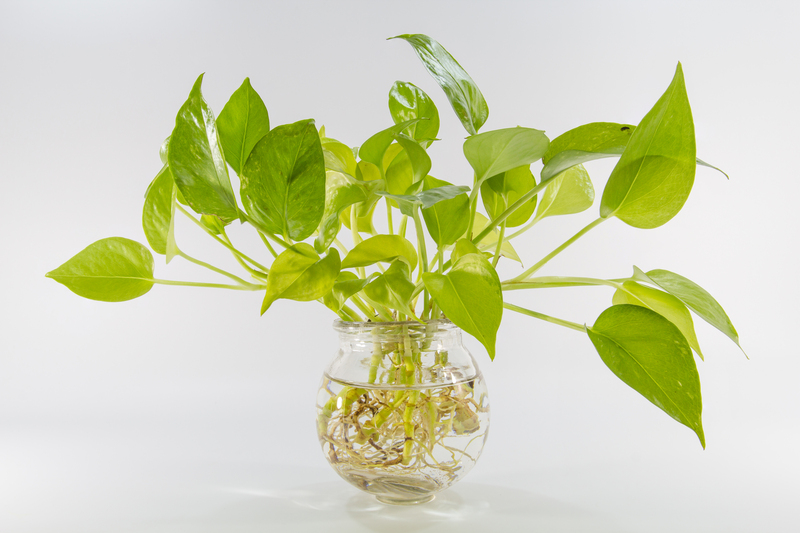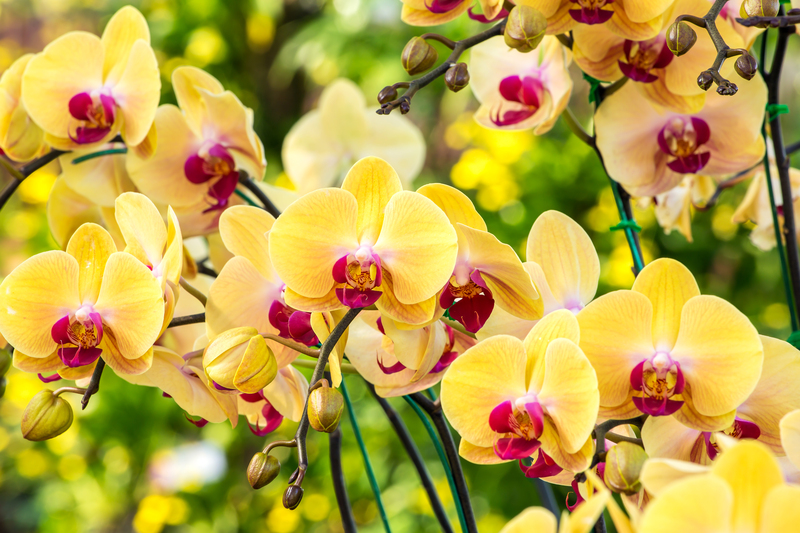Evergreen Climbers for Shade: Transforming Gloom into Green
Posted on 23/08/2025
Evergreen Climbers for Shade: Transforming Gloom into Green
If you have a shady corner in your garden or a north-facing wall that looks perpetually drab, you're not alone. Many gardeners struggle with lackluster, lifeless areas due to limited sunlight. Fortunately, by introducing evergreen climbers for shade into your landscaping, you can effortlessly convert those gloomy spots into vibrant, living green spaces. This comprehensive guide explores the best shade-tolerant evergreen climbing plants, their benefits, care tips, and creative ideas to help you design a year-round haven of lushness.
Why Choose Evergreen Climbers for Shaded Areas?
Evergreen climbing plants for shade are invaluable for any garden. Unlike their deciduous counterparts, evergreen climbers retain their foliage throughout the seasons, offering year-round privacy, color, and structure. They're excellent for hiding unsightly walls, fences, or sheds, and can also provide shelter for wildlife. Most importantly, these plants thrive in areas where sunlight is scarce, making them ideal problem solvers for shaded gardens.
Advantages of Planting Evergreen Climbers in Shady Gardens
- Continuous Greenery: Enjoy a lush backdrop 365 days a year.
- Low Maintenance: Many shade-tolerant climbers require minimal upkeep once established.
- Wildlife Attraction: Foliage offers shelter for birds and pollinators, boosting garden biodiversity.
- Screening and Privacy: Ideal for covering trellises, walls, or creating private corners.
- Cooling Effect: Shaded areas feel cooler and more comfortable in hot climates.
- Versatility: Work well in combination with other plants, and suitable for both small urban spaces and larger country gardens.

Top Evergreen Climbers for Shade
Choosing the right evergreen climbers for shady spots can seem overwhelming. Let's discover some of the finest choices, ranging from traditional favorites to hidden gems, that will thrive even where sunshine struggles to reach.
1. Ivy (Hedera helix and Hedera varieties)
Ivy is among the most reliable and versatile evergreen climbers for shade. Its glossy, lobed leaves cloak walls, fences, and trees quickly, making it perfect for those needing urgent coverage. English Ivy (Hedera helix) and its cultivars are tolerant of deep shadow, tough, and drought-resistant once established.
- Key Features: Dense, evergreen foliage; fast-growing; excellent for wildlife.
- Ideal Locations: Walls, shady fences, ground cover in woodland gardens.
- Care Tips: Prune regularly to control growth and encourage bushier habits. Avoid letting ivy climb vulnerable trees or old brickwork to prevent damage.
2. Star Jasmine (Trachelospermum jasminoides)
Though often associated with sun, Star Jasmine is surprisingly shade-tolerant and offers spectacular results in dappled shade. Its dark, shiny foliage remains evergreen, while clusters of fragrant, star-shaped white flowers bloom generously from late spring to summer.
- Key Features: Sweetly scented; attractive to pollinators; slow to moderate growth rate.
- Ideal Locations: Shady pergolas, north-facing walls, containers in patios with filtered sunlight.
- Care Tips: Mulch annually for moisture retention and feed during spring for vigorous growth. Prune after flowering as needed.
3. Climbing Hydrangea (Hydrangea anomala subsp. petiolaris)
The Climbing Hydrangea is a shade garden superstar. Its heart-shaped, dark green leaves create a handsome, lush backdrop, complemented by large, white, lace-cap flowers in early summer. In winter, its peeling bark adds architectural interest, making it a truly year-round performer.
- Key Features: Self-clinging; tolerant of deep shade; showy summer blooms.
- Ideal Locations: North or east-facing walls, fences, large tree trunks.
- Care Tips: Provide moist, well-drained soil. Give support while young, then let it self-anchor. Slow to get established, but pays off with perseverance.
4. Evergreen Clematis (Clematis armandii)
Among the few clematis species that retain their foliage in winter, Clematis armandii is a welcome addition for any shaded position. Its long, leathery, glossy leaves and masses of fragrant, star-like white flowers (spring-blooming) create a captivating spectacle.
- Key Features: Hardy; fragrant; rapid grower once established.
- Ideal Locations: Part-shade pergolas, arbors, fences.
- Care Tips: Likes fertile, well-drained soils. Prune after flowering and feed regularly in spring and summer.
5. Japanese Honeysuckle (Lonicera japonica 'Halliana')
Japanese Honeysuckle is known for its vigorous, twining growth and delicious scent. Its semi-evergreen to evergreen habit in mild areas makes it an excellent choice for shady spaces seeking a fragrant, wildlife-friendly touch.
- Key Features: Prolific; sweetly scented summer flowers; attractive to bees and butterflies.
- Ideal Locations: Shady boundary fences, trellises, pergolas.
- Care Tips: Prune annually to control spread and rejuvenate old plants. Provide support for climbing stems.
6. Wintercreeper (Euonymus fortunei)
Wintercreeper is a tough, shade-loving evergreen that can work as ground cover or scramble up walls and supports when provided. Its dense, variegated foliage offers year-round visual interest, making it highly versatile.
- Key Features: Tolerant of dry shade; various color forms; compact grower.
- Ideal Locations: Shaded walls, woodland gardens, underplanting for larger climbers.
- Care Tips: Little pruning needed. Water during prolonged dry spells and mulch annually to improve soil texture.
7. Canary Creeper (Senecio angulatus)
Senecio angulatus, or Canary Creeper, is an unusual evergreen climber thriving in mild, frost-free locations. Its fleshy, scallop-edged leaves remain bright green in shade, while daisy-like yellow flowers bloom in autumn.
- Key Features: Fast-growth; drought tolerance; attractive foliage and flowers.
- Ideal Locations: Shady courtyards, covered walls, conservatories.
- Care Tips: Needs protection from hard frost. Cut back in spring to maintain size and shape.
How to Choose the Best Evergreen Climber for Your Shady Spot
Not all shady areas are the same, so it's essential to evaluate your garden's unique conditions before selecting an evergreen climbing plant for shade. Consider the following factors:
Assess the Light Level
- Deep Shade: Very little to no direct sunlight (e.g., north-facing walls, under dense trees).
- Dappled Shade: Filtered sunlight through branches or partial overhangs.
- Partial Shade: 3-4 hours of direct sun, often morning or late afternoon.
For deep shade, opt for tried-and-true survivors like ivy, euonymus, or climbing hydrangea. Dappled or partial shade opens possibilities for trachelospermum (star jasmine), evergreen clematis, and honeysuckle.
Check Soil Moisture and Drainage
Consistent moisture benefits most shade evergreen climbers. If your soil is dry and poor, improve it with organic matter and mulch to retain moisture. However, avoid waterlogged conditions, which can cause root rot.
Space and Support
- Vertical Space: Ensure you have enough room for climbers to spread without overwhelming their supports.
- Supports: Install trellises, wires, or allow some climbers (like ivy or hydrangea) to self-cling to suitable surfaces.
Designing with Evergreen Climbers in Shaded Gardens
Utilizing evergreen climbing plants for shade opens up a world of design opportunities for turning gloomy, overlooked areas into focal points. Here are some creative ways to use these resilient plants:
1. Green Living Walls
Train fast-growing climbers like ivy or euonymus up a wall or trellis to create a lush, vertical tapestry. This is ideal for adding privacy to small city gardens or courtyards where ground space is at a premium.
2. Shaded Entryways
Frame a shaded porch or doorway with a fragrant climber such as star jasmine or evergreen clematis. The year-round foliage and seasonal blooms will welcome guests and soften architectural lines.
3. Woodland Walkways
Enhance the natural ambiance of a woodland garden by letting climbing hydrangea clothe the trunks of mature trees. Underplant with ferns and hostas for layered, shaded beauty.
4. Privacy Screens and Windbreaks
Combine vigorous shade climbers for fences or trellises that need coverage--ivy paired with scented honeysuckle can form a living, wildlife-friendly boundary, reducing wind and noise while offering seclusion.
Year-Round Care for Shade-Loving Evergreen Climbers
For success with evergreen shade climbers, good aftercare is crucial, especially in their establishment phase. Follow these top tips:
- Watering: Newly planted climbers need consistent moisture. Mature plants generally cope with dry shade, but always water during prolonged dry spells.
- Mulching: Apply a layer of organic mulch in early spring to conserve soil moisture and regulate temperature.
- Feeding: Most shade-evergreen climbers benefit from a balanced slow-release fertilizer in spring.
- Pruning: Trim back after flowering or as needed to manage growth and encourage bushier, healthier foliage.
- Check for Pests: Slugs, snails, and vine weevils can be a problem in cool, moist shade. Inspect regularly and use organic deterrents.

Frequently Asked Questions About Evergreen Climbers for Shade
Can evergreen climbers grow in full shade?
Yes! Some species like ivy, wintercreeper, and climbing hydrangea are highly tolerant of deep shade. However, ensure soil is not waterlogged and provide additional feeding, as light is limited.
Are evergreen shade climbers suitable for containers?
Absolutely. Many, like star jasmine, evergreen clematis, and euonymus, perform well in large pots with good quality compost and regular watering. Place containers in shaded courtyards or balconies for instant greenery.
Which evergreen climber for shade grows the fastest?
English ivy and Senecio angulatus (in frost-free areas) are among the fastest-growing shade climbers. Japanese honeysuckle can also be vigorous, so plan space and prune to prevent invasiveness.
Do evergreen climbers damage walls?
Self-clinging climbers like ivy and climbing hydrangea can root into old mortar or crumbling brickwork. Always ensure surfaces are sound before letting these plants grow up them. For delicate structures, use wire supports or opt for twining climbers like clematis or jasmine.
Conclusion: Breathe Life Into Shady Spaces With Evergreen Climbers
No longer must those dark, overlooked corners of your garden remain dull or empty. By carefully selecting and nurturing shade-tolerant evergreen climbing plants, you can dramatically transform any area into a lush, vibrant retreat that delights through every season. Whether you crave the classic charm of ivy and hydrangea, the fragrance of star jasmine, or the lush texture of wintercreeper, there's an evergreen climber perfectly suited to your needs.
Start with healthy plants, provide good soil and initial care, and you'll be rewarded with enduring greenery that turns gloom into a glorious, living tapestry of green. With the right evergreen climbers for shade, every garden--no matter how sun-starved--can become a hidden paradise.

